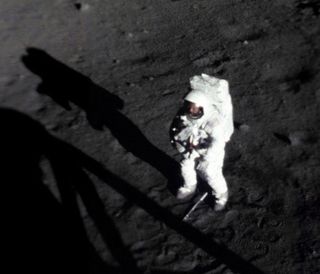Science & Culture: Is Brain Project the Apollo of Our Time?

This spring, President Obama announced what could be this generation's defining national science effort — an ambitious mission to map the human brain. In its size and scope, the project could claim a place in human culture on par with previous landmarks, like the moon landings and the Human Genome Project, experts say.
Big, national science efforts do more than just direct the science-funding spigot; they can also become a part of the culture. These kinds of national undertakings seep into the arts, pop culture — and the popular consciousness, said Cyrus Mody, a professor of science, technology and engineering at Rice University. "People start to think in the terms that define these projects."
The brain-mapping initiative (officially BRAIN, for Brain Research through Advancing Innovative Technlogies) headlines a series of White House "Grand Challenges," defined as "ambitious goals on a national or global scale that capture the imagination." The point, then, is not simply to tackle big questions, but also to shape the culture. [The 10 Biggest Mysteries of the Mind]
Place in history
Science projects have arguably their greatest cultural effects when they become a shared historical memory. The archetype for historically significant Big Science would seem to be Neil Armstrong's first steps on the moon. The lunar landing occupies a haloed place in American history books; as A.O. Scott notes, the date of Armstrong's first small steps — July 20, 1969 — held a place beside Oct. 11, 1492, and July 4, 1776, on his elementary school wall, and likely many others.

Digging a little deeper, however, it becomes clear that Apollo's present place in history wasn't always so secure. Once the initial sensation faded, the public didn't quite know what to make of Armstrong and Buzz Aldrin's steps, said Matt Tribbe, a historian of science and technology at the University of Houston.
It took a couple decades for the moon landings to attain the iconic status they enjoy today. In the '80s, the movie "The Right Stuff" and the space shuttle launches generated more interest in Apollo, Tribbe said. Historical perspective can be tough to predict, and it may likewise take time for the true legacy of the BRAIN initiative to become clear.
Sign up for the Live Science daily newsletter now
Get the world’s most fascinating discoveries delivered straight to your inbox.
Ultimately, BRAIN's historical place may more closely resemble that of the Genome Project, celebrated not so much as an iconic, single event, but as a highly meaningful exploration. President Bill Clinton described it as microbiology's equivalent of Lewis and Clark's expedition, calling it "the most important, most wondrous map ever produced by mankind." Many outside observers agreed, calling the genome effort more significant than Apollo or the Manhattan Project, in its probing of a fundamental aspect of human identity. [Unraveling the Human Genome: 6 Molecular Milestones]
Mapping the brain, perhaps even more so, also mines human identity, making it particularly significant to the public, said Ralph Greenspan, associate director of the Kavli Institute for Brain and Mind at UC, San Diego, and one of the initial proponents of the BRAIN project. "It cuts much deeper and is more encompassing than any other medical subject," Greenspan said. "It's the whole question about who we are."
Money motivations
Unlike the moon missions, neither Genome nor BRAIN could rely on the most compelling motivation for Apollo: the Cold War. Interpreted culturally as a potential victory over the Soviets, the moon missions successfully (though, not easily) secured its total $25 billion in funding, Tribbe said.
The Genome Project and BRAIN initiative instead derive cultural meaning, and consequent funding priority, from the importance the public places on medical science, Mody said. "The public is concerned about health and is inspired by research about the human being, what it is to be human and what we can do to help human beings."
Obama has noted that the $3 billion Genome Project returned nearly $800 billion to the economy, predicting a proportionate return-on-investment for BRAIN's initial $100 million investments.
Big Science in the popular vocabulary
The historical significance and cultural urgencies associated with Big Science projects have also, unsurprisingly, vaulted them into the worlds of pop culture and art.
"In the high and low literature of the '60s and '70s, Apollo is all over," Mody said. Later pop culture responses reflect the prominent historical perch Apollo eventually attained. Its '80s renaissance also saw the pop culture immortalization of Armstrong's moonwalk in the logo for the new MTV (which recently received an update for the 2013 MTV awards).
Big Science has continued to ripple throughout high and low culture ever since, Mody said. "Artists today are very much interested in reflecting a culture in which science plays such a huge role," he said. This certainly proved true with the Genome Project, and BRAIN will likely follow a similar path, he said.
The Genome Project placed the perspectives and language of genetics in the popular lexicon, Mody said, "proposing the idea that genetics tells us a whole lot about who we are and what our fates will be."
Brain mapping should enter the public conversation in a similar way, Mody said. "There will be more widespread talk of social and behavioral traits as being emergent from the brain," he said. Theories, like the currently popular explanations of religion as a brain-centered phenomenon, will gain greater currency. [Inside the Brain: A Photo Journey Through Time]
Brain mapping may find a role in a future Hollywood dystopia, too. Anxieties about Big Science projects have historically lent themselves well to expression in popular science fiction. A pre-Apollo Big Science effort, the Manhattan Project, not only birthed the atomic bomb, but also gave rise to "Godzilla" and other monster movies, Mody said. In those films, radiation from atomic blasts creates angry mega-lizards, which then serve as an embodiment of the anxieties and awe of the atomic age, Mody said. Similarly, in 1993's "Jurassic Park," T. rex and kin embodied the power and dangers of genetic technology.
High arts
Big Science has influenced the high arts just as much as it has pop culture. Literary responses in the first few decades after Armstrong's small steps often reflected the public's ambivalence to the mission. John Updike described a detached viewing of the landing, while Norman Mailer's "Of a Fire on the Moon" expressed disillusionment with the bureaucrat-led conquest of Earth's satellite. But writers were clearly interested in treating the event, Mody said.
After the Genome Project, artists could be seen using genetic techniques to alter plants or make a rabbit glow, for example, Mody said. Paul Vanouse at SUNY Buffalo, in particular, has turned genetic engineering tools and products into artwork, using DNA replication experiments to produce visual designs and turning a genetics lab into performance art.
The high arts are already responding to neuroscience investigations, and the BRAIN initiative will only accelerate that interest, said Sheldon Brown, a UC, San Diego professor of visual arts who's own artwork marries neuroscience measurement with the creation of immersive, digital worlds. His own artwork marries neuroscience measurement with the creation of immersive, digital worlds. Brown hopes to develop artistic experiences that adapt to individuals' cognitive responses to virtual environments.
Follow Michael Dhar on Twitter @mid1980. Follow us @livescience, Facebook& Google+. Original article on LiveScience.com.

Michael Dhar is a science editor and writer based in Chicago. He has an MS in bioinformatics from NYU Tandon School of Engineering, an MA in English literature from Columbia University and a BA in English from the University of Iowa. He has written about health and science for Live Science, Scientific American, Space.com, The Fix, Earth.com and others and has edited for the American Medical Association and other organizations.
Most Popular

